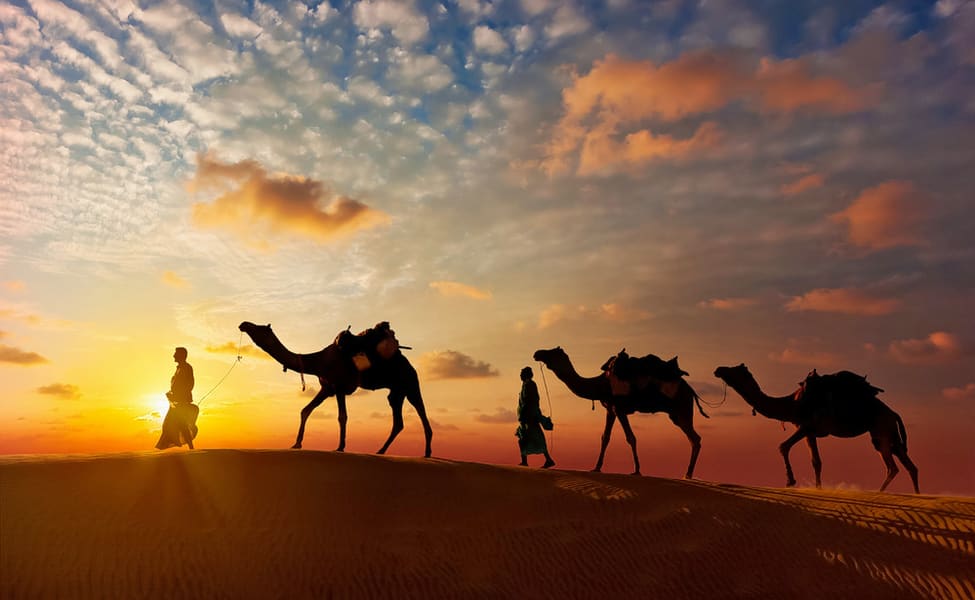
Explore the Royal Palaces of Rajasthan: Where History Comes Alive
By JKV Travel
Welcome to the Land of Kings!
When you step into Rajasthan, you’re not just visiting a state you're stepping into a living museum of royal glory, timeless traditions, and larger-than-life stories. Every brick in its majestic forts and palaces echoes with the whispers of Rajputana valour, grandeur, and legacy.
In this blog, we invite you on an unforgettable journey to explore the royal palaces of Rajasthan, each one a masterpiece of art, architecture, and history. Whether you're a history buff, a culture lover, or a curious traveller, Rajasthan’s palaces promise to mesmerize you.
1. City Palace, Jaipur – The Heart of the Pink City
Nestled in the heart of Jaipur, the City Palace is not just a structure it's a living heritage. Built by Maharaja Sawai Jai Singh II, this palace is a fine blend of Rajput and Mughal architecture.
As you walk through the ornate gateways like Virendra Pol and Udai Pol, you’re welcomed by intricate frescoes, sprawling courtyards, and breathtaking halls. The Mubarak Mahal, now a museum, houses royal costumes and artifacts, while the Chandra Mahal, still home to the royal family, offers panoramic views of the Pink City.
Don’t miss the four seasonal gates in Pritam Niwas Chowk, each symbolizing a different season.
2. Umaid Bhawan Palace, Jodhpur – Luxury of a Bygone Era
Perched atop Chittar Hill, the Umaid Bhawan Palace is one of the world’s largest private residences, still partially inhabited by the Jodhpur royal family. Built between 1928 and 1943, it’s a stunning blend of Art Deco and Indo-Saracenic architecture.
Made from golden sandstone, the palace shines under the desert sun. Part of the palace is a Taj luxury hotel, offering a royal experience to its guests, while another part functions as a museum showcasing vintage cars, clocks, and royal memorabilia.
It’s not just a palace, it’s a timeless ode to royal opulence.
3. Lake Palace, Udaipur – A Dream Floating on Water
Imagine a white marble palace floating like a mirage on Lake Pichola that’s Lake Palace, also known as Jag Niwas. Built in 1746 by Maharana Jagat Singh II, this stunning palace-turned-hotel is now operated by the Taj Group.
Accessible only by boat, the palace reflects in the tranquil waters, creating a dreamlike setting. The architecture is rich in Mewar artistry, featuring lotus-shaped fountains, marble columns, and ornamental gardens.
Sunset boat rides around the palace are a photographer’s paradise.
4. Junagarh Fort & Palace, Bikaner – A Fort Never Conquered
Unlike most forts in Rajasthan built on hills, Junagarh Fort stands boldly in the plains of Bikaner. It was constructed in the 16th century by Raja Rai Singh and remarkably, it was never captured by enemies.
Within its fortified walls lie several palaces such as Anup Mahal, Badal Mahal, and Phool Mahal each adorned with gold leaf, hand-painted ceilings, and fine mirror work. The fort’s museum takes you through the rich history of Bikaner and its valiant rulers.
A must-visit for those who want to walk through a warrior’s past.
5. Hawa Mahal, Jaipur – The Palace of Winds
Though not a palace in the traditional sense, the Hawa Mahal is perhaps the most iconic structure in Jaipur. Built in 1799 by Maharaja Sawai Pratap Singh, it allowed royal women to view street processions without being seen.
The façade is like a honeycomb, made of pink sandstone, with 953 small jharokhas (windows) that allow cool air to pass through, making it an architectural marvel.
6. Mehrangarh Fort and Palaces, Jodhpur – Majesty in the Skies
Towering 400 feet above Jodhpur, the Mehrangarh Fort is one of the most formidable and best-preserved forts in India. Within its walls are several palaces like Moti Mahal, Phool Mahal, and Sheesh Mahal, each narrating stories of Rajput glory.
The museum here is a treasure chest of palanquins, paintings, costumes, and weapons used by the royals. The panoramic view of the blue houses of Jodhpur from the ramparts is breathtaking.
Mehrangarh isn’t just a fort it’s a book of legends written in stone.
Frequently Asked Questions – Answered by JKV Travel
1. Which is the most famous royal palace in Rajasthan?
Ans: The City Palace of Jaipur is one of the most iconic royal palaces, known for its architecture and royal heritage.
2. Can I stay in any of the royal palaces of Rajasthan?
Ans: Yes, palaces like Umaid Bhawan Palace (Jodhpur) and Lake Palace (Udaipur) have been converted into luxury heritage hotels.
3. What is the best time to visit Rajasthan’s palaces?
Ans: The ideal time to visit is from October to March, when the weather is pleasant for sightseeing.
4. Are guides available at these palace sites?
Ans: Yes, professional guides and audio tours are available at most royal palaces for a richer historical experience.
5. How can JKV Travel help in booking Rajasthan palace tours?
Ans: JKV Travel offers customized Rajasthan heritage tour packages, including palace visits, stays, transport, and local guides.
Final Thoughts: Rajasthan – Where Palaces Whisper Stories of the Past
From the shimmering Lake Palace in Udaipur to the grand City Palace of Jaipur, the royal palaces of Rajasthan are more than historical structures they’re living tales of love, power, art, and resilience.
Visiting Rajasthan is like stepping into a different era, where time slows down and grandeur takes center stage. If you truly want to experience Indian history in its most magnificent form, these palaces are not just places to see they’re places to feel.
So, are you ready to walk through the pages of history and explore the royal palaces of Rajasthan? Let the journey begin!
Also Read: Plan Your Trip Better!
Want to explore Jaipur like a true local and make the most of your visit to its royal palaces?
Don’t miss our guide: Best Time to Visit Jaipur & Must-Do Activities in Every Season– discover what to see, eat, and experience throughout the year!




